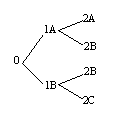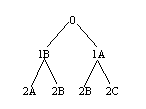






(defstruct node (name "") (children nil))
(defvar g1 (let* ((2a (make-node :name "2A"))
(2b (make-node :name "2B"))
(2c (make-node :name "2C"))
(1a (make-node :name "1A" :children (list 2a 2b)))
(1b (make-node :name "1B" :children (list 2b 2c))))
(make-node :name "0" :children (list 1a 1b))))
(defun test-graph (root-node &rest keys)
(apply #'clim:format-graph-from-root root-node
#'(lambda (node s)
(write-string (node-name node) s))
#'node-children keys))
Evaluating
(test-graph g1 :stream *my-window*)
results in the following graph:

In Figure 32., the graph has a horizontal orientation and grows toward the right by default. We can supply the
:orientation
keyword to control this. Evaluating
(test-graph g1 :stream *my-window* :orientation :vertical)
results in the following graph:

The following example uses format-graph-from-roots to create a graph with multiple parents, that is, a graph in which node D is a child of both nodes B and C. Note that it interprets its first argument as a list of top-level graph nodes, so we have wrapped the root node inside a list.
(defun test-graph (win)
(window-clear win)
(format-graph-from-roots '((a (b (d)) (c (d))))
#'(lambda (x s) (princ (car x) s))
#'cdr
:stream win
:orientation :vertical
:merge-duplicates t
:duplicate-key #'car)
(force-output win))
Common Lisp Interface Manager 2.0 User's Guide - 20 Sep 2011